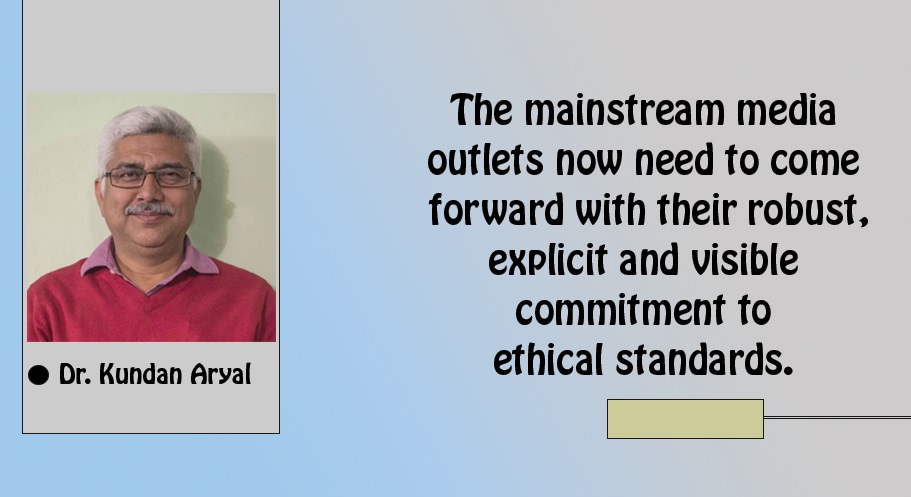Dr. Kundan Aryal
Despite different platforms and medium of expression, journalism has played an innovative role with the passage of time. Media have been constantly evolving, and today the new media have cultivated human behaviour around the world. Online mass media, which serve edited contents, and social media or Social Network Sites, which ventilate individual opinions, go hand in hand in this digital era.
Three decades have elapsed since the dawn of free press in 1990 when Nepal witnessed rapid changes in the media landscape. The political transformation from an authoritarian state to a multiparty democracy gave birth to large-scale newspapers under corporate management, which promoted a diversity of perspectives. Harold Innis, a Canadian communication scholar, rightly argues that the physical attributes of media have been pushing the societies and ideas in new directions. Nepal is no exception.
Impact
Over the years, media have undergone different phases with evolution of political systems. It saw the advent of modernity in the mid-20th century to the age of the Internet and subsequently media convergence. The visible change in the media ecosystem has continued. As US communication scholar Marshall T. Poe, in his seminal work, A History of Communications: Media and Society from the Evolution of Speech to the Internet, dwells on the mass media’s impact on social lives, post-1990 Nepal has been witnessed significant changes in three major spheres – medium attributes, network attributes and, social practices and values.
Evolution of media, their growing impact on Nepali society, and changes in human behaviour will continue in the days to come. The first transition of the Nepali media, following the political changes of 1990, resulted in massive circulation of newspapers across the country. In the second transition at the turn of the new millennium saw breakthroughs in interactive new media technology, with consumers gradually shifting from print to digital platforms.
After the outbreak of COVID-19, the country witnessed the flood of online news portals that marked 3rd transition Nepali media. The annual report of the Press Council Nepal 2020 states that as many as 2,138 online news portals started between July 2019 and July 2020. Only five newspapers were registered during the same period. A medium is a tool for sending, receiving, storing, and retrieving information. If we examine these fundamental uses, we would conclude that a useful and gratifying medium would be inexpensive to obtain and easy to use.
Hence, the most recent digital transition, which began around the new millennium, has reshaped the entire Nepali media landscape. As every new technology of communication creates a new environment for producers and consumers, the shift seen in the journalism sphere has both challenges and prospects. The emergence of an expressive public with a higher level of interactivity would be proved to be an opportunity for the mass media.
The state of media convergence needs to be conducive to create a sustained communication atmosphere with the empowered citizenry. Change in material existence from paper to digital platform or endurance of digital transformation in the newsrooms needs to be aimed at presenting the truth without fear or favour and based on the doctrine of fairness. As the history of civilisation tells that the role of journalism to reveal truth remains unchanged, the physical appearances have gone through drastic alteration.
The unprecedented growth and pervasiveness of Social Network Sites have empowered every individual with communicative competence. Thus, in the age of multiple alternative information channels beyond the mass media outlets, the journalists could hold their link to the audience only through the well-researched, verified and edited or processed content produced by following an independent and responsible journalistic process. Mass media would be felt essential for electorates when they could provide informed choices to them concerning their day-to-day socio-political affairs.
Apart from the immediate facet linked with technology, professional and ethical dimensions are equally pertinent in creating a sustained mass media atmosphere in the days to come. First, mass media need to give more emphasis on public trust with abidance of the professional and ethical standards of journalism. Second, mass media should continue to explore the more supplementary and complementary roles of social media in disseminating news and views or media message. The emergence of social media has posed challenges before traditional journalism. But there are opportunities as well. It depends on the creativity of our media practitioners or journalists: How can they prove themselves responsible, accountable and trustworthy in this age of communication super highway.
Media literacy
The mainstream media outlets now need to come forward with their robust, explicit and visible commitment to ethical standards. Finally, they need to declare their rules for conduct aimed at escalating media literacy among the general public. The public would get an effective yardstick to scale their performance so that media outlets will get objective feedback to rectify the lapses or to be more sensitive toward people from different walks life.
A comprehensive, workable and evidence-based media policy to create a people-centric media system is a must to meet the normative expectations. Likewise, the media industry should strive to prove its relevance with the quality of message and satisfy the audience of the 21st century, who are equipped with sophisticated technology. In other words, amidst advanced media technology and pervasive social media, how can Nepali mass media be effective for the people in terms of cognition, functions or social utility? This question will impel us to find the innovative role of journalism, news and social media in the days to come.
[Dr. Kundan Aryal is an esteemed academician and media professional with extensive experience in the field of journalism, media studies, and communication. He is a Head of TU Central Department of Journalism and Mass Communication.]

MORE NEWS
Young leadership in choice, Saugat wins with respectable votes
Baglung flood: Three killed as flood sweeps away motorcycle and scooter
‘Youth in slogans many times, Youth in leadership this time’ – Saugat Thapa [Video]
Gold hits all-time high price record today